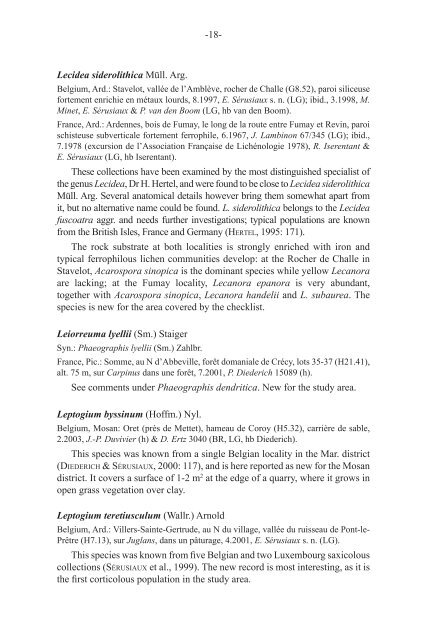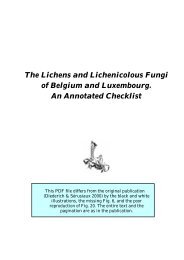LEJEUNIA - Lichens of Belgium, Luxembourg and northern France
LEJEUNIA - Lichens of Belgium, Luxembourg and northern France
LEJEUNIA - Lichens of Belgium, Luxembourg and northern France
Create successful ePaper yourself
Turn your PDF publications into a flip-book with our unique Google optimized e-Paper software.
Lecidea siderolithica Müll. Arg.<br />
-18-<br />
<strong>Belgium</strong>, Ard.: Stavelot, vallée de l’Amblève, rocher de Challe (G8.52), paroi siliceuse<br />
fortement enrichie en métaux lourds, 8.1997, E. Sérusiaux s. n. (LG); ibid., 3.1998, M.<br />
Minet, E. Sérusiaux & P. van den Boom (LG, hb van den Boom).<br />
<strong>France</strong>, Ard.: Ardennes, bois de Fumay, le long de la route entre Fumay et Revin, paroi<br />
schisteuse subverticale fortement ferrophile, 6.1967, J. Lambinon 67/345 (LG); ibid.,<br />
7.1978 (excursion de l’Association Française de Lichénologie 1978), R. Iserentant &<br />
E. Sérusiaux (LG, hb Iserentant).<br />
These collections have been examined by the most distinguished specialist <strong>of</strong><br />
the genus Lecidea, Dr H. Hertel, <strong>and</strong> were found to be close to Lecidea siderolithica<br />
Müll. Arg. Several anatomical details however bring them somewhat apart from<br />
it, but no alternative name could be found. L. siderolithica belongs to the Lecidea<br />
fuscoatra aggr. <strong>and</strong> needs further investigations; typical populations are known<br />
from the British Isles, <strong>France</strong> <strong>and</strong> Germany (HERTEL, 1995: 171).<br />
The rock substrate at both localities is strongly enriched with iron <strong>and</strong><br />
typical ferrophilous lichen communities develop: at the Rocher de Challe in<br />
Stavelot, Acarospora sinopica is the dominant species while yellow Lecanora<br />
are lacking; at the Fumay locality, Lecanora epanora is very abundant,<br />
together with Acarospora sinopica, Lecanora h<strong>and</strong>elii <strong>and</strong> L. subaurea. The<br />
species is new for the area covered by the checklist.<br />
Leiorreuma lyellii (Sm.) Staiger<br />
Syn.: Phaeographis lyellii (Sm.) Zahlbr.<br />
<strong>France</strong>, Pic.: Somme, au N d’Abbeville, forêt domaniale de Crécy, lots 35-37 (H21.41),<br />
alt. 75 m, sur Carpinus dans une forêt, 7.2001, P. Diederich 15089 (h).<br />
See comments under Phaeographis dendritica. New for the study area.<br />
Leptogium byssinum (H<strong>of</strong>fm.) Nyl.<br />
<strong>Belgium</strong>, Mosan: Oret (près de Mettet), hameau de Coroy (H5.32), carrière de sable,<br />
2.2003, J.-P. Duvivier (h) & D. Ertz 3040 (BR, LG, hb Diederich).<br />
This species was known from a single Belgian locality in the Mar. district<br />
(DIEDERICH & SÉRUSIAUX, 2000: 117), <strong>and</strong> is here reported as new for the Mosan<br />
district. It covers a surface <strong>of</strong> 1-2 m 2 at the edge <strong>of</strong> a quarry, where it grows in<br />
open grass vegetation over clay.<br />
Leptogium teretiusculum (Wallr.) Arnold<br />
<strong>Belgium</strong>, Ard.: Villers-Sainte-Gertrude, au N du village, vallée du ruisseau de Pont-le-<br />
Prêtre (H7.13), sur Juglans, dans un pâturage, 4.2001, E. Sérusiaux s. n. (LG).<br />
This species was known from five Belgian <strong>and</strong> two <strong>Luxembourg</strong> saxicolous<br />
collections (SÉRUSIAUX et al., 1999). The new record is most interesting, as it is<br />
the first corticolous population in the study area.





